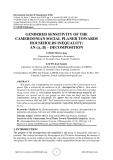
http://www.iaeme.com/IJM/index.asp 1 editor@iaeme.com
International Journal of Management (IJM)
Volume 10, Issue 2, March-April 2019, pp. 1-8, Article ID: IJM_10_02_001
Available online at http://www.iaeme.com/ijm/issues.asp?JType=IJM&VType=10&IType=2
Journal Impact Factor (2019): 9.6780 (Calculated by GISI) www.jifactor.com
ISSN Print: 0976-6502 and ISSN Online: 0976-6510
© IAEME Publication
GENDERED SENSITIVITY OF THE
CAMEROONIAN SOCIAL PLANER TOWARDS
HOUSEHOLDS INEQUALITY:
AN (Α, Β) – DECOMPOSITION
TCHITCHOUA Jean
Department of Quantitative Economics,
University of Yaoundé 2-Soa, Yaoundé, Cameroon.
KAFFO Jean Faustin
Laboratory of Analysis and Research in Mathematical Economics (LAREM),
University of Yaoundé 2-Soa. Yaoundé, Cameroon.
Correspondence: KAFFO Jean Faustin, LAREM, University of Yaoundé 2-Soa, Po.Box. 5611
Yaoundé, Cameroon. E-mail: kaffojfaustin@gmail.com.
ABSTRACT
This paper aims at highlighting the inequality aversion of the Cameroonian social
planer. This is allowed by the multilevel (α, β) - decomposition of the α - Gini which
integrate in its functional form a parameter of inequality aversion of the decision maker
being related either to within-group inequality (α) or between-group inequality (β).
Analysis are carried out by sex groups on data from the third and the fourth
Cameroonian Survey on households. It’s appear that the overall inequality index
decrease between 2001 and 2007. The Cameroonian social planer appears sensitive to
both within group and between group households’ inequalities following decomposition
by sex.
Keywords: Multilevel (α, β)-decomposition, inequality aversion, decomposition by
population sub-groups, between and within groups inequalities, Cameroon.
Cite this Article: TCHITCHOUA Jean and KAFFO Jean Faustin, Gendered
Sensitivity of the Cameroonian Social Planer Towards Households Inequality: An (Α,
Β) – Decomposition, International Journal of Management, 10 (2), 2019, pp. 1-8.
http://www.iaeme.com/IJM/issues.asp?JType=IJM&VType=10&IType=2
1. INTRODUCTION
The property of the decomposition into population’s sub-group of inequalities indicators is
essential. This concept developed by Bourguignon in 1979 allows determining the amount of
the disparities of income without knowing the exact characteristics of the distributions of the
sub-groups. He shows that the total inequality within a population divided into several groups





















